|
Patented in 1913, the
Wilson Fluted Wobbler remained in the company's production for many
years. This is the introductory picture box that disappeared after 1918
or so. The flyer inside has color pictures of Wilson lures in beautiful
colors, but for some reason they are most often found in red and white.
|
 |
|
The Cupped Wobbler, made
in the mid teens, features a hollowed out head with a well-made nickel
line-tie protruding from the opening. It was likely very noisy and
successful as a plunking type lure. it was made only briefly, and came
in its own picture box.
|
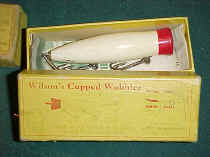 |
The
"Good Luck" Wobbler is almost identical to the Fluted Wobbler
pictured above. Note the different box style, which dates to the early
teens. There is a four-leaf clover on the boxtop that is absent on many
other cartons by the same famous company. Wobblers came in all
shapes and sizes and white/red flutes is the most common color.
|
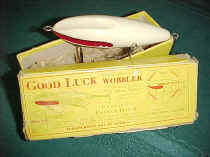 |
Here
is another Wilson's Fluted Wobbler in the earliest style white box with
red and green lettering. THis box is slightl shorter and shallower than
the yellow boxes shown above. Instead of a parent date, this hard-to-fing
Hastings Sporting Goods Works box simply has the patent number,
1080873. The Wilson Wobbler lure inside is yellow with red flutes,
and the box endflap is correctly marked 631-Y.
|
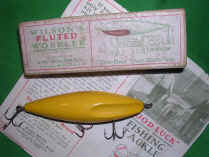 |
|
The Algers Gets Em bait
was acquired by the Wilson Hastings Company from another tackle maker,
Franklin Alger of Michigan. The plug has an elaborate metal armature on
the belly with a mechanism that supposedly makes it weedless. The boxes
for this lure are exponentially rarer than the lure. I believe this to
be the rarest Wilson box, as I have seen only one other example.
|
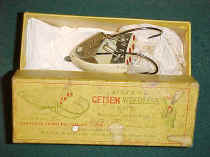 |
|
The Six-in-One lure has
a little ratchet and gearbox on the nose so the diving lip can be
adjusted six different ways. This is a Michigan classic, and the
company's most desirable lure. It was introduced in1915 and patented in
1917. Although short-lived in production, it came with its beautiful
introductory picture box.
|
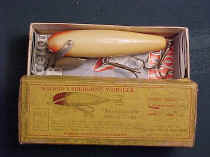 |
|
The Winged Wobbler, or
Flanged Wobbler as it was also called, featured metal wings that would
make the lure behave strangely, like a wounded baitfish. This pretty box
with cat tails on the cover is the Wilson company's later, generic box
used for all the lures that remained in production by the mid 1920s.
|
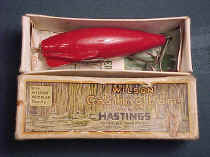 |
|
This all-red Fluted
Wobbler is in another "cat tails" box, and correctly marked
for somewhat rare color. Later Wilson Wobblers all came in these
handsome boxes, after the yellow picture boxes were phased out to make
packaging easier.
|
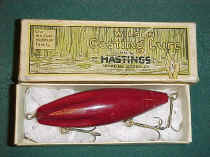 |
|
The Super Wobbler is a shorter,
plumper variation of the Fluted Wobbler, and comes in its own special
early box, dated 1913. These lures have two trebles instead of the usual three. Super
Wobbler boxes are among the hardest Wilsons to find, and it is almost
impossible to find the lure in colors other than red and white. This
near-mint specimen, which came to us from a noted Ohio collector named
Bill, is in brown scale.
|
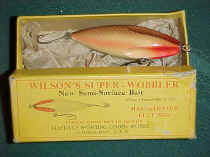 |
|
This beautiful rainbow
colored Fluted
Wobbler is in the hard-to-find white picture box with yet another
variation of the Wilson Wobbler logo. These boxes may be a bit earlier
than the relatively common yellow Wobbler boxes. White boxes are hard to
photograph because of the glare they produce.
|
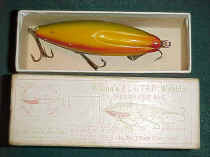 |
|
This early version of
the Winged, or Flanged Wobbler, has unpainted wings, unlike the all-red
example in the later box above. This yellow box dates to around 1915 and
includes a picture of the lure and information about its action in the
water. Although faded, this is the best example of this early box I've
been able to find.
|
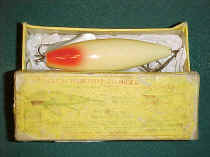 |